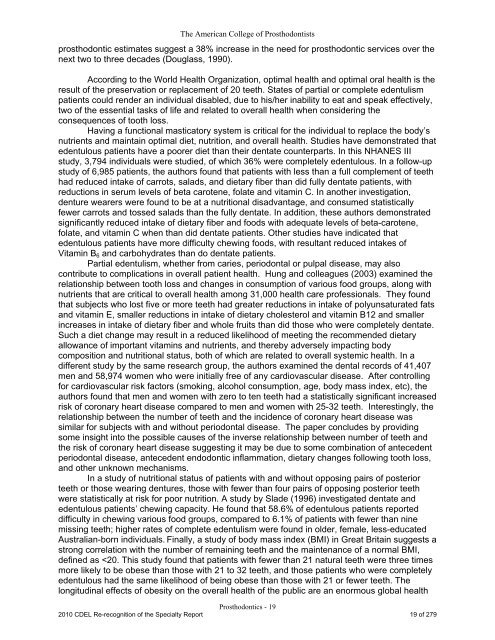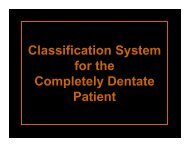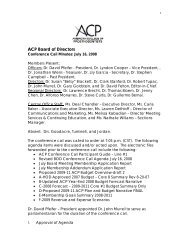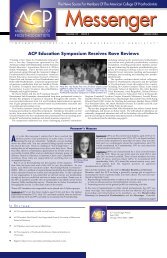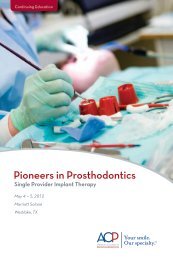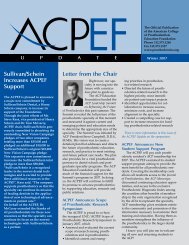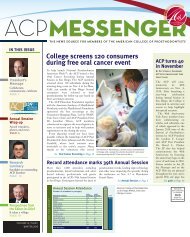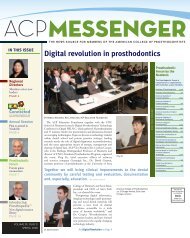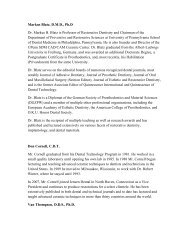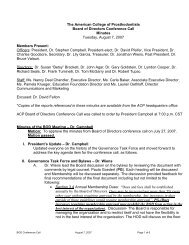PROSTHODONTICS - American College of Prosthodontists
PROSTHODONTICS - American College of Prosthodontists
PROSTHODONTICS - American College of Prosthodontists
You also want an ePaper? Increase the reach of your titles
YUMPU automatically turns print PDFs into web optimized ePapers that Google loves.
The <strong>American</strong> <strong>College</strong> <strong>of</strong> <strong>Prosthodontists</strong>prosthodontic estimates suggest a 38% increase in the need for prosthodontic services over thenext two to three decades (Douglass, 1990).According to the World Health Organization, optimal health and optimal oral health is theresult <strong>of</strong> the preservation or replacement <strong>of</strong> 20 teeth. States <strong>of</strong> partial or complete edentulismpatients could render an individual disabled, due to his/her inability to eat and speak effectively,two <strong>of</strong> the essential tasks <strong>of</strong> life and related to overall health when considering theconsequences <strong>of</strong> tooth loss.Having a functional masticatory system is critical for the individual to replace the body’snutrients and maintain optimal diet, nutrition, and overall health. Studies have demonstrated thatedentulous patients have a poorer diet than their dentate counterparts. In this NHANES IIIstudy, 3,794 individuals were studied, <strong>of</strong> which 36% were completely edentulous. In a follow-upstudy <strong>of</strong> 6,985 patients, the authors found that patients with less than a full complement <strong>of</strong> teethhad reduced intake <strong>of</strong> carrots, salads, and dietary fiber than did fully dentate patients, withreductions in serum levels <strong>of</strong> beta carotene, folate and vitamin C. In another investigation,denture wearers were found to be at a nutritional disadvantage, and consumed statisticallyfewer carrots and tossed salads than the fully dentate. In addition, these authors demonstratedsignificantly reduced intake <strong>of</strong> dietary fiber and foods with adequate levels <strong>of</strong> beta-carotene,folate, and vitamin C when than did dentate patients. Other studies have indicated thatedentulous patients have more difficulty chewing foods, with resultant reduced intakes <strong>of</strong>Vitamin B 6 and carbohydrates than do dentate patients.Partial edentulism, whether from caries, periodontal or pulpal disease, may alsocontribute to complications in overall patient health. Hung and colleagues (2003) examined therelationship between tooth loss and changes in consumption <strong>of</strong> various food groups, along withnutrients that are critical to overall health among 31,000 health care pr<strong>of</strong>essionals. They foundthat subjects who lost five or more teeth had greater reductions in intake <strong>of</strong> polyunsaturated fatsand vitamin E, smaller reductions in intake <strong>of</strong> dietary cholesterol and vitamin B12 and smallerincreases in intake <strong>of</strong> dietary fiber and whole fruits than did those who were completely dentate.Such a diet change may result in a reduced likelihood <strong>of</strong> meeting the recommended dietaryallowance <strong>of</strong> important vitamins and nutrients, and thereby adversely impacting bodycomposition and nutritional status, both <strong>of</strong> which are related to overall systemic health. In adifferent study by the same research group, the authors examined the dental records <strong>of</strong> 41,407men and 58,974 women who were initially free <strong>of</strong> any cardiovascular disease. After controllingfor cardiovascular risk factors (smoking, alcohol consumption, age, body mass index, etc), theauthors found that men and women with zero to ten teeth had a statistically significant increasedrisk <strong>of</strong> coronary heart disease compared to men and women with 25-32 teeth. Interestingly, therelationship between the number <strong>of</strong> teeth and the incidence <strong>of</strong> coronary heart disease wassimilar for subjects with and without periodontal disease. The paper concludes by providingsome insight into the possible causes <strong>of</strong> the inverse relationship between number <strong>of</strong> teeth andthe risk <strong>of</strong> coronary heart disease suggesting it may be due to some combination <strong>of</strong> antecedentperiodontal disease, antecedent endodontic inflammation, dietary changes following tooth loss,and other unknown mechanisms.In a study <strong>of</strong> nutritional status <strong>of</strong> patients with and without opposing pairs <strong>of</strong> posteriorteeth or those wearing dentures, those with fewer than four pairs <strong>of</strong> opposing posterior teethwere statistically at risk for poor nutrition. A study by Slade (1996) investigated dentate andedentulous patients’ chewing capacity. He found that 58.6% <strong>of</strong> edentulous patients reporteddifficulty in chewing various food groups, compared to 6.1% <strong>of</strong> patients with fewer than ninemissing teeth; higher rates <strong>of</strong> complete edentulism were found in older, female, less-educatedAustralian-born individuals. Finally, a study <strong>of</strong> body mass index (BMI) in Great Britain suggests astrong correlation with the number <strong>of</strong> remaining teeth and the maintenance <strong>of</strong> a normal BMI,defined as


